The barn owl is a sedentary bird that constantly lives in the same territory. Of all our owls, the barn owl is considered the most nocturnal species; it appears only late in the evening and hunts in complete darkness. All-day the owl sits in some kind of shelter: in the attic or in the hollow of a tree. Barn owls feed mainly on mouse-like rodents, as well as shrews, moles, amphibians, eat insects, and hunt birds. Owls also come across quite large prey: rats, squirrels, muskrats, rabbits. Barn owls inhabit a variety of habitats. In our country, this bird is almost universally associated with human housing.
Barn Owl Description, Size, & Physical Characteristics
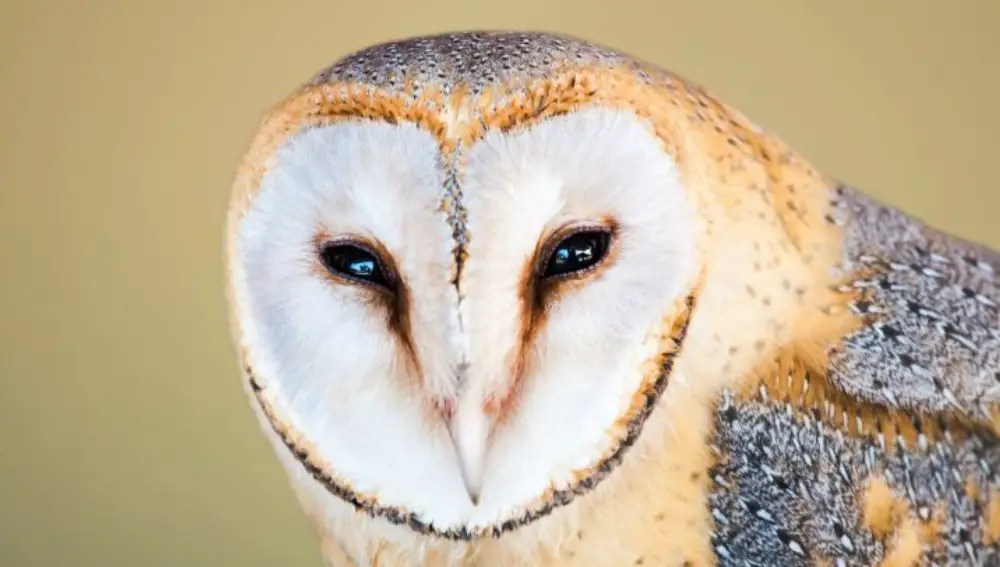
In appearance, the barn owl may seem very similar to an owl, only unusually beautiful, with soft and fluffy plumage, slender body, long legs. And this is not accidental, because the barn owl belongs to the order of owls. This bird, like many other members of the order, is nocturnal and prefers to hunt in the dark. But unlike many species of wood owls, most barn owls, especially the most common species – the common barn owl – settle next to a person. This bird has an extremely amazing head – its facial corolla of feathers resembles a heart in shape, which distinguishes the entire genus of barn owls. And the barn owl owes its not the most euphonious name to the same discordant voice. True, at normal times these birds are quite silent, but during the breeding season they emit hoarse and rattling cries, and they also snap their beaks and flap their wings exponentially. The barn owl prefers to lead a solitary lifestyle. And only occasionally in places characterized by an abundance of prey, barn owls are found in groups. Interestingly, human activity has only a beneficial effect on the distribution of many species of barn owls. Barn owls try to avoid dense forests and mountainous areas, therefore, clearing forests to establish agriculture contributes to the extensive settlement of these birds.
Tyto Owl
Kingdom: Animals
Type: Chordates
Subtype: Vertebrates
Class: Birds
Subclass: Newcomers
Order: Owls
Family: Barn owl
Genus: Barn owls
The barn owl is easy to distinguish from other owls. It does not have feathers that resemble ears and has a heart-shaped facial disc that looks like a mask, which is why the bird is otherwise called the mask. Another common name for the barn owl is the barn owl, which the bird received just because of its habitation next to humans. The approximate size of a barn owl is 30-40 cm. Body length, 80-90 cm. Wingspan. This bird has a large round head, an elongated body, fully feathered legs, and a short tail. Barn owls are distinguished by the unusual structure of the hearing aid. Their ears are located asymmetrically – one in the forehead, the other at the level of the nostrils. This allows barn owls to better perceive sounds made by live prey. The beak and upper beak in most species of barn owls are light, except for the black representatives of the genus.
This predator has an unusual and varied coloration. The lower half of the body in barn owls is usually darker, sometimes speckled. But in different species of barn owls, this color may differ. The especially beautiful color of feathers in the common barn owl. The back and wings are of a reddish-brown shade with a gray speck, with dark and light spots. The lower part of the body in some subspecies is snow-white, and in some, it has a dark speck. The color of the plumage of the golden barn owl is dominated, respectively, by yellowish tones. In low light at night, this bird seems, indeed, enveloped in a golden glow. The Cape barn owl has a pronounced spotted coloration of the abdominal part of the body. The Tasmanian barn owl is larger than many members of the genus. Its back and wings are noticeably darker than the rest of the body, and the facial disc also stands out due to the dark brown color of the feathers. The ashtray of the barn owl is characterized by an ash-gray facial crown and a dark gray streaky pattern on the plumage. The herbaceous oriental barn owl is distinguished by black and gold blotches on the back and wings and a dark, almost black “covering” of the upper part of the head. The small black barn owl is also called silver due to the predominance of a gray-variegated shade in its color. Sometimes there are also completely black individuals. The Australian barn owl is the largest of all barn owls, it differs from the ordinary one with a thin dark border along the contour of the facial corolla. The Madagascar barn owl is also called red because of the noticeable orange tint of the wings. The color of the feathers of the great black barn owl is dominated by black and dark gray tones; it is also sometimes called a black owl. The barn owl is dark brown with white spots and ocher blotches.
Barn Owl Habitat – Black, White & Baby Barn Owls
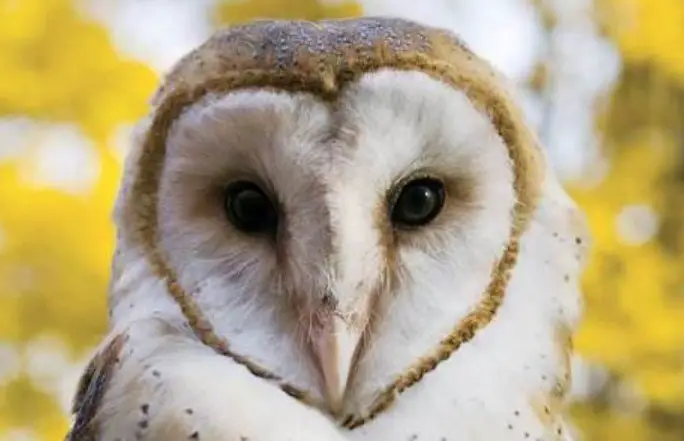
Almost every species of barn owls is tied to a specific habitat, only in Australia there are different species of these birds, and in Africa, Madagascar, and Southeast Asia, relict representatives of the genus have even survived. These barn owls are gigantic in size compared to modern birds. The most extensive habitat is occupied by the common barn owl. It is found throughout Europe, including in Russia, and in the near abroad, as well as on the African continent, in the Middle East in the Persian Gulf countries, in South and Southeast Asia – in territories with a warm climate, in New Guinea and aforementioned Australia, as well as everywhere in America, with the exception of Canada and Alaska, precisely because of the northern cold – the common barn owl does not tolerate them. The ash-faced barn owl is endemic to the islands of Haiti and the Dominican Republic. The golden barn owl is also endemic to the islands of New Britain, New Guinea, and Australia. The Tasmanian barn owl is a species native to the forests of Tasmania but also occurs in open areas. In the South Andaman Islands, the Andaman barn owl population has become isolated. The Cape Verde barn owl has accordingly settled in South America. Minahasa, black-brown, and Sulawesian barn owls are characteristic of the territories of Southeast Asia, in particular, the Sulawesi island. Herbal barn owl lives in the Himalayas, India, China, Taiwan, Burma, and Vietnam. The Manus barn owl inhabits the territory of the island of Manus I in Papua New Guinea. The small black barn owl, like the common one, as well as the Australian, settled in the tropical rainforests of Australia, in the same area there is also a large black barn owl. The small barn owl has taken root on the islands of the Indonesian archipelago. The Madagascar species, like the Australian, prefers the moist forests of Northeastern Madagascar. The barn owl can be found in countries such as Ethiopia, Uganda, Kenya, Angola, Zambia, Zimbabwe, as well as in Indonesia, Australia, and other eastern islands up to Melanesia.
Barn owl Behavior and Lifestyle
The night owl is another name for the barn owl, which determines its relationship with the order of owls. During the day, this bird rests (for daytime sleep, barn owls sometimes gather in groups), and at night it flies out to hunt. In-flight, the barn owl periodically changes its altitude, examining its possessions in search of prey, or arranges ambushes. She flies so silently that the victim often does not hear the approach of danger. This feature is characteristic of barn owls, thanks to the special ends of the flight feathers on their wings. This bird has equally well-developed day and night vision. And in addition to vision – excellent hearing, which the barn owl is endowed with, thanks to the auditory openings passing at different angles, as well as the reflector, the role of which is played by the “mask” feathers framing the facial corolla. Dwelling in nature mainly in open areas, the barn owl does not like it when a stranger wanders into its territory and, upon meeting him, arranges to intimidate “performances” – spreads its wings wide, flaps them, approaches a border violator, hisses at him and clicks his beak. And if this does not help, then the barn owl boldly attacks the enemy and hits him with strong paws. Living next to a person, the barn owl can build a nest somewhere in the attic or in a barn, and in the wild, it prefers to settle in tree hollows, small mountain caves, or occupy other people’s holes and nests. The life expectancy of a barn owl in the wild can be up to 18 years. But in most cases, these birds rarely live longer than 2 years.
Food
The main food of barn owls is various murine rodents. But sometimes barn owls also hunt small birds, rabbits, frogs, reptiles, large beetles, and even bats. Different subspecies, living in different localities, adapt to hunting local animals. For example, the Malaysian barn owl eats palm rats that are characteristic of the area. Australian species prey on house mice. The prey of the barn owl, which lives in Europe and America, is a mouse-like rodent such as voles, rats, and shrews. This bird from the order of owls, due to the peculiarities of its nutrition, has a beneficial effect on human agriculture, keeping the number of rodents at a normal level.
Species and Subspecies
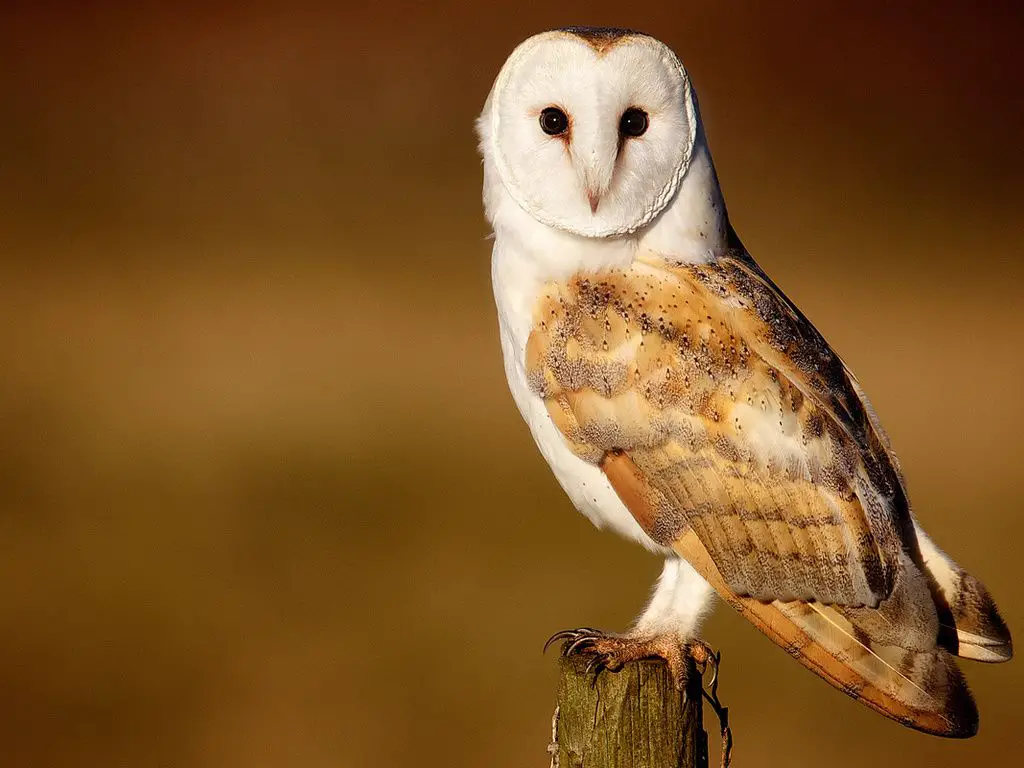
Researchers consider some of the bird species listed below as subspecies. However, according to this modern classification, many subspecies of the barn owl eventually became completely independent species.
Tyto alba – Common barn owl. It has about 46 subspecies, more details about which can be found in the article on the common barn owl on our website:
Tyto aurantia – Golden or bismarck barn owl
Tyto castanops – Tasmanian or burrow barn owl
Tyto deroepstorffi – Andaman barn owl
Tyto detorta – Cape Verde Barn owl
Tyto glaucops – Ash-faced barn owl
Tyto inexspectata – Minakhas barn owl
Tyto longimembris – Oriental herbal barn owl
Tyto manusi – Manus barn owl
Tyto multipunctata – Small black barn owl
Tyto navaehollandiae – Australian barn owl
Australian barn owl subspecies:
Tyto novaehollandiae manusi
Tyto novaehollandiae sororcula
Tyto novaehollandiae castanops
Tyto nigrobrunnea – Black-brown barn owl or Taglabu
Tyto rosenbergii – Sulawesian barn owl
Tyto sororcula – Small barn owl
Tyto soumagnei – Madagascar barn owl
Tyto tenebricosa – Large black barn owl
Tyto capensis – African or herbal barn owl
Barn owl subspecies:
Tyto capensis capensis
Tyto capensis cameroonensis
Tyto capensis damarensis
Tyto capensis liberatus.
Barn Owl Reproduction
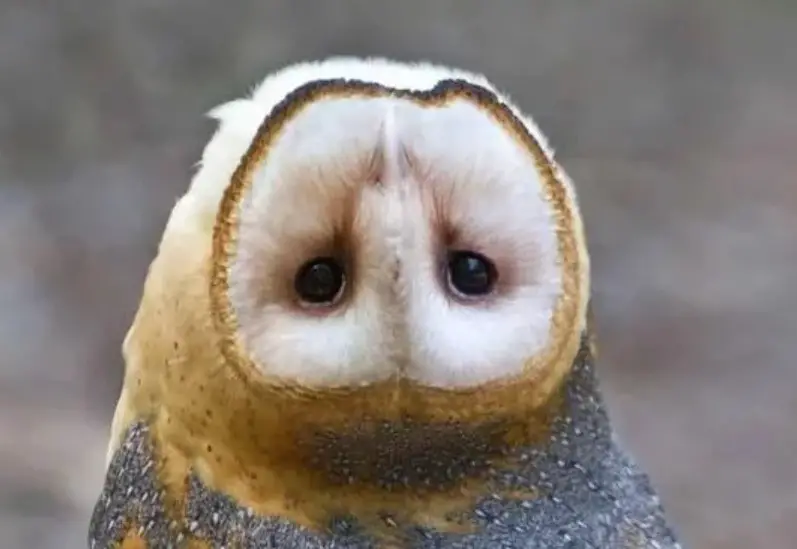
During the mating season, barn owls are characterized by monogamous relationships. When it is time for breeding, the male chooses a tree for nesting, and flies around it, attracting the female with hoarse cries. In the mating season, the game of “catch-up” is widespread among straight barn owls – the male chases the female and both birds at the same time hoarsely and shout sharply. The beginning of the mating season in different areas is associated with the climate and the amount of food. In warm climates, barn owls can breed all year round, in the north they prepare for mating in the spring, and in particularly hot and arid areas at the end of the dry season. Usually, barn owl chicks are born 1-2 times a year, but in some habitats, for example, in Malaysia, three clutches were found per year. During nesting, males and females keep together, equipping a place for laying in the dense crown of trees. Barn owls do not always build a nest themselves, sometimes they lay their eggs in a hollow or even a burrow on the coast of some body of water, and sometimes they also lay eggs in a human dwelling where there are suitable conditions. The average number of eggs in a nest is 4-7, but there are also larger clutches – up to 14 eggs. The size of each egg is approximately 3 cm, the color of the shell is beige or white. The female barn owl incubates eggs for about a month. During this period, the male becomes the main food provider. Chicks hatch absolutely helpless, covered with soft white fluff. Parents feed them together, and only after a month and a half do the young gain the ability to leave the nest, and independent flights are made after 50 days. And yet, for three whole months, little barn owls live next to their parents.
Melanistic Barn Owl
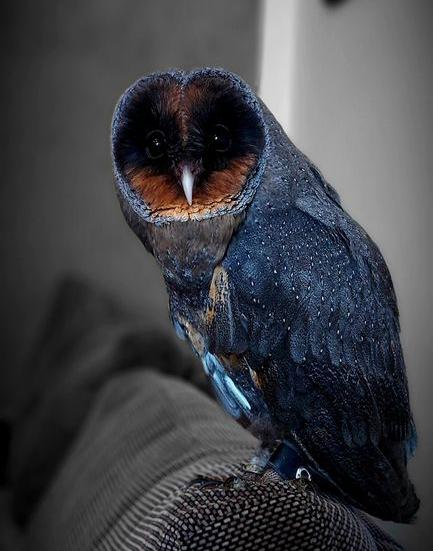
Melanism (from the Greek μέλας – “black”) is a phenotype, the predominant distribution of dark-colored individuals in any kind of organisms. Black, brown, or brown coloration of the outer covers of animals, determined by pigments melanins, arises as a result of hereditary changes and can be “picked up” by natural selection if dark forms are more viable than light ones. So, sometimes a dark color turns out to be protective, for example, in the case of the so-called. industrial melanism – the displacement of light forms of butterflies and other insects by dark ones in areas with significant industrial pollution (for example, in the birch moth, Biston betularia in Great Britain). In other cases, the spread of melanism is not associated with the adaptive value of dark coloration and may correlate with some physiological characteristics of organisms or reflect random genetic shifts in populations.
The black or ash barn owl is one of the rarest and least studied representatives of the barn owl. Birds of this genus have a rather unusual appearance, by which they can be easily distinguished from their closest relatives. They are found mainly in the Australian open spaces and on some islands in Oceania. For its characteristic dark color of plumage, this barn owl is often called a black owl.
Melanistic Barn Owl Appearance
Ash barn owl is a medium-sized bird. The sizes of females vary between 44-50 cm, and the weight is 0.9-1.1 kg. Males are an order of magnitude smaller: their dimensions do not exceed 35-43 cm, and their weight is no more than 600-700 g. The wingspan of these barn owls reaches 1.03 m.
The color of the plumage of the black barn owl is dominated by ash-black colors, for which this bird received its main species names. The lower part of the abdomen is also dark, but with predominant small black spots forming an uneven pattern. The paws of these birds are dark gray, and the claws are black.
The color of the face disk is rounded, ranging from light gray to graphite, with the lightest tones at the edge and the darkest tones closer to the center. It is framed at the edges with a black stripe. Juveniles can be easily distinguished by their darkest facial disc.
Large black eyes complement the mystical image of this owl. The feathery “ears” of the ash barn owl are absent, the wings and tail are rather short. On the head, there are many small light dots-spots, on the wings they are larger but less common.
The vocalization of black barn owls is quite varied, but mainly whistling sounds prevail, which are compared to a falling bomb. They are also characterized by chirping and popping sounds, which are usually emitted by insects. Chicks begging for food emit a semblance of squeak.
Habitat
Ash barn owl is a rare inhabitant of the Australian continent. It is found mainly in the east and northeast of the country, with the exception of some parts of the vast territories of Queensland. Also, these birds are found in the vastness of New Guinea, where their population is more extensive than the Australian one.
It is for these two habitats that the main varieties of black barn owls are distinguished. The Australian subspecies is distinguished by smaller dimensions (weight – 500-750 g) and a predominant brown color.
These birds settle mainly in moist eucalyptus forests near the coast and among the dense southern tropical jungle, but they also do not shun forest edges. At the same time, they can choose both lowlands and high-altitude places for nesting (they are found at an altitude of up to 3600 m).
Lifestyle and Diet of Melanistic Barn Owl
Barn owls are exclusively nocturnal predators (they fly out to hunt in the middle of the night), which, given the inaccessible habitats, does not allow researchers to obtain full information about the behavioral characteristics of these birds. It is only known that they are not picky in the choice of food sources.
These barn owls hunt a wide variety of animals. Their diet is dominated by small and medium-sized mammals (mainly opossums, large rats, and bats). Much less often they hunt small birds and reptiles. Black barn owls lookout for their prey, hiding among dense foliage, and, having outlined potential food, quickly rush at it from an ambush.
Reproduction
These owls do not have a definite mating season. Barn owls can breed at any time of the year. But still, they mainly try to acquire offspring in the period from January to June. Although there were cases when these birds formed pairs in August-September.
Males at this time become the noisiest, trying to attract the attention of females with their whistling calls. Forming a pair, these barn owls carefully arrange their dwelling, choosing for it a hollow in an old tree at a height of 10 to 50 m and lining the bottom with a soft litter.
If there are no suitable trees in the area, then these owls can equip nests in caves. The choice of a nesting abode usually falls on the shoulders of the female, which settles in it well before laying eggs.
A clutch of black barn owls contains no more than 1-2 eggs. They are incubated exclusively by the female for about 1.5 months, and the male at this time provides her with food (during the night hunt, he flies to her with the food obtained a couple of times). In chicks, plumage appears only at the end of the 3rd month of life. After that, they live with their parents for some time, and then leave them to begin their independent arrangement.
Barn owls form stable pairs, but not during the breeding season they live separately and do not even intersect in the same area. These owls have almost no natural enemies in nature, but they reproduce slowly, so their populations are few (for example, in the north of Queensland there are about two thousand pairs). Deforestation is the main threat to them.
Barn Owl in Flight (Wings)
The barn owl is an owl of light build, weighing about 300 – 350 grams, with long wings, noticeably protruding beyond the tail. Although its flight does not seem fast due to the measured flaps of its wings, it is nevertheless quite swift and nimble. The bird then flies at a considerable height above the roofs of houses or the tops of trees, it descends almost to the ground itself.
The barn owl has a light body and a large wing area, with which it is enough to make small-amplitude movements.
Cute Barn Owls, Nesting, Baby
Compared to other owls, the barn owl is perhaps the most nocturnal bird. She spends the whole day in some niche or in a hollow and shows signs of activity only late in the evening. Barn owl chicks, taken out into the light, immediately strive to huddle in any crevice. In chicks of other owls, this habit is not so pronounced.
The coloration of the barn owl remarkably matches the rocky landscape. If a bird sits motionless, pressed against a stone wall, it is almost invisible. At the same time, it stands out well against the background of greenery and dark tree trunks. The bottom of the barn owl’s body is most often painted in pale ocher tones. The back and wings are darker, reddish, or brownish. If you look at the bird from a close distance, you can see on the upper side of the body a golden streaky pattern, on the bottom – the smallest dark speck. But in the color of birds, there can be very significant geographical differences: in the west of Europe, the most intensely colored individuals live, the dominant color of the plumage of which is brown; in the south, the color of the feather is dominated by a reddish tone; in the east of the range, birds are usually pale. The iris of the eyes is always dark brown. The beak is grayish, rarely yellowish. The nails are black.
The voice of an adult barn owl is a rough, hoarse, harsh rattle: “heee”. This sound is generally low, but occasional shouts can be high. The voice of young birds, which they begin to give a few days after hatching, is basically the same as the cry of adult birds, although, of course, it is much weaker. It gradually gets stronger, it gets louder. The hissing of a young barn owl, which, obviously, is the name of the owl, most often means that it is hungry. Her quiet chatter indicates that she is cold. When frightened, starting from two weeks of age, chicks emit a threatening hiss. This sound is not at all like their usual hoarse exclamations.
In defensive situations, the barn owl, like other owls, sharply clicks its beak. At the same time, the lower part of her facial disc moves amusingly together with the mandible. Here, we note that the barn owl does not have a threat pose so spectacular and characteristic of many representatives of the family of true owls. Instead, it spreads its wings in a horizontal plane and lies down, leaning to the ground, and the plumage on the body is tightly pressed.
When the bird walks on the ground or eaves of houses, then three toes turns forward and one back. Moving along the branches, she puts her paw differently: the female places the first and second fingers on one side, the third and fourth on the other. If the owl is simply resting on a branch, then most often the second and third fingers are facing forward, while the first and fourth are directed backward.
We have never seen a barn owl take food in its paw and bring it to its mouth, as other owls do. She kills her victim with claws and, stepping on it, tears it apart with her beak. In mice, it usually tears off and swallows first the front part of the body, then sends the rest to the stomach. It seems that while eating, the barn owl grimaces tirelessly. This is due to the fact that when the mouth is opened and closed, the feathers of the facial disc are automatically set in motion along with the beak. They then deviate back, which makes the bird take on an outlandish disheveled appearance, and the beak, as it were, moves forward, then returns to its previous position. When the beak is “extended” forward, the lower eyelids are pulled up and the eyes are closed. The owl swallows a piece of meat – and the expression on its “face” again becomes normal.
Barn owl food is quite diverse. However, most often the victims of this owl are murine rodents and shrews. Owls living in cities intensively hunt for sparrows that spend the night in trees.
Like all owls, the barn owl periodically regurgitates pellets. They are 3.5 – 8.0 centimeters long and approximately 3 centimeters in diameter. Barn owl pellets sometimes contain many chitinous remains of small insects. This is probably because owls, feeding on sparrows, for example, swallow them together with a stomach filled with insects. The barn owl itself, if it catches insects, is mainly the largest – May beetles, hawk moths, and others.
The spring excitement of the barn owl, accompanied by regular calls, is noted in most areas of its distribution already in March. From the end of April, the female starts laying. Its eggs are relatively small – 41×30 millimeters and weigh about 18 grams, dull-white, oblong. A full clutch contains 6 – 8 eggs. The development of embryos lasts approximately thirty days. Chicks do not grow very quickly, gaining final weight only by the age of three months.
There is evidence that the female barn owl actively contributes to the earliest hatching of chicks. Sometimes she begins to break off the edges of the shell around the hole formed when the chick is pecking. The enlargement of the hole and the squeak of the owlet in the egg stimulates its activity. When the chick is half free, the mother breaks off already significant pieces of the shell, until, finally, she completely removes it. This behavior is generally not very typical for birds. Chicks usually hatch on their own, without the help of their parents.
From two weeks of age, barn owl chicks are already watching the situation with interest. Around the same time, they begin to shake their heads, acquiring skills in locating the victim. At this age, the owlet eats a whole mouse at a time and can do this five to six times a night. Young owls leave the nest in 35 – 45 days, far from reaching the size of an adult bird.

